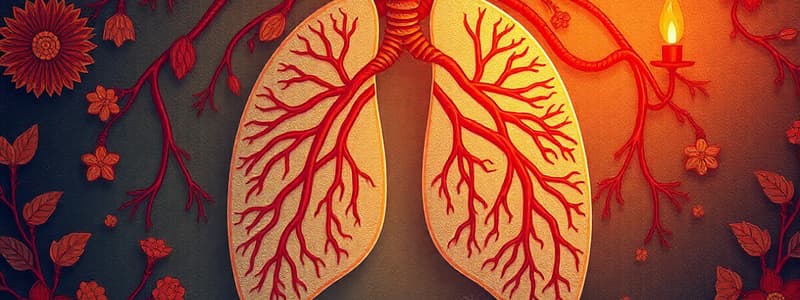Podcast
Questions and Answers
ما هو نوع الدم الذي تُحمله الشرايين الرئوية؟
ما هو نوع الدم الذي تُحمله الشرايين الرئوية؟
- دم مُؤكسج
- دم مُنخفض الأكسجين (correct)
- مزيج من الدم المُؤكسج والمُنخفض الأكسجين
- لا يوجد دم في الشرايين الرئوية
ما هو الفرق الأساسي بين الدورة الدموية الرئوية والدورة الدموية الجهازية؟
ما هو الفرق الأساسي بين الدورة الدموية الرئوية والدورة الدموية الجهازية؟
- الدورة الدموية الرئوية تمر عبر الرئتين، بينما الدورة الدموية الجهازية تمر عبر باقي الجسم.
- كل ما سبق صحيح (correct)
- الدورة الدموية الرئوية تحمل الدم المؤكسج، بينما الدورة الدموية الجهازية تحمل الدم غير المؤكسج
- الدورة الدموية الرئوية ذات ضغط منخفض، بينما الدورة الدموية الجهازية ذات ضغط مرتفع.
ما هو دور الأوردة الرئوية في الدورة الدموية؟
ما هو دور الأوردة الرئوية في الدورة الدموية؟
- نقل الدم غير المؤكسج من القلب إلى الرئتين
- نقل الدم المؤكسج من القلب إلى باقي الجسم
- نقل الدم غير المؤكسج من الرئتين إلى القلب
- نقل الدم المؤكسج من الرئتين إلى القلب (correct)
أين يحدث تبادل الغازات في الجهاز الدوري؟
أين يحدث تبادل الغازات في الجهاز الدوري؟
ما الذي يحدث بشكل أساسي في الدورة الدموية الجهازية؟
ما الذي يحدث بشكل أساسي في الدورة الدموية الجهازية؟
ما هو الفرق الأساسي بين الشرايين والأوردة؟
ما هو الفرق الأساسي بين الشرايين والأوردة؟
ما الذي يُساعد على ضمان وصول الدم إلى جميع أنحاء الجسم في الدورة الدموية الجهازية؟
ما الذي يُساعد على ضمان وصول الدم إلى جميع أنحاء الجسم في الدورة الدموية الجهازية؟
ما الذي يُشكل الدورة الدموية الرئوية؟
ما الذي يُشكل الدورة الدموية الرئوية؟
Flashcards
الدورة الدموية الرئوية
الدورة الدموية الرئوية
الجزء من الدورة الدموية الذي يحمل الدم غير المؤكسد من القلب إلى الرئتين.
الدورة الدموية الجهازية
الدورة الدموية الجهازية
يتحمل النظام المسؤول عن نقل الدم المؤكسد من القلب إلى باقي الجسم.
الفرق بين الدورة الرئوية والجهازية
الفرق بين الدورة الرئوية والجهازية
الدورة الرئوية منخفضة الضغط، في حين أن الدورة الجهازية عالية الضغط.
الشرايين الرئوية
الشرايين الرئوية
Signup and view all the flashcards
الأوردة الرئوية
الأوردة الرئوية
Signup and view all the flashcards
الشريان الأورطي
الشريان الأورطي
Signup and view all the flashcards
الطرفيات
الطرفيات
Signup and view all the flashcards
الأوردة
الأوردة
Signup and view all the flashcards
Study Notes
Pulmonary Circulation
- Pulmonary circulation is the portion of the circulatory system that carries deoxygenated blood away from the heart to the lungs, and returns oxygenated blood back to the heart.
- It forms a closed loop from the right ventricle to the lungs, and back to the left atrium.
- The right ventricle pumps deoxygenated blood into the pulmonary artery.
- The pulmonary artery branches into smaller arterioles and capillaries within the lungs.
- Gas exchange occurs in the capillaries; deoxygenated blood releases carbon dioxide, and absorbs oxygen from the inhaled air.
- Oxygen-rich blood then flows through venules and into the pulmonary veins.
- The pulmonary veins carry oxygenated blood back to the left atrium of the heart, completing the pulmonary circuit.
Systemic Circulation
- Systemic circulation is responsible for carrying oxygenated blood from the heart to the rest of the body and returning deoxygenated blood back to the heart.
- It's a major circuit, traversing the entire body.
- The left ventricle pumps oxygenated blood into the aorta, the largest artery in the body.
- The aorta branches into smaller arteries, arterioles, and capillaries throughout various tissues and organs.
- In the capillaries, oxygen and nutrients are delivered to cells, and carbon dioxide and waste products are collected.
- Deoxygenated blood flows from the capillaries into venules and then into larger veins.
- Eventually, deoxygenated blood returns to the heart via the superior and inferior vena cava, entering the right atrium.
- This completes the systemic circuit.
Differences between Pulmonary and Systemic Circulation
- Pulmonary circulation:
- Carries blood to the lungs for gas exchange.
- Low-pressure system.
- Uses thin-walled blood vessels to facilitate gas exchange.
- Systemic circulation:
- Carries blood to the rest of the body.
- High-pressure system to ensure blood reaches all tissues.
- Contains a wider variety of blood vessels (arteries, veins) with thicker walls, to withstand the pressure.
Key Differences in Blood Vessels
- Pulmonary Arteries: Carry deoxygenated blood from the heart to the lungs.
- Pulmonary Veins: Carry oxygenated blood from the lungs to the heart.
- Aorta: The largest artery; carries oxygenated blood from the heart to the rest of the body.
- Venules: Small vessels that collect blood from capillaries and carry it to veins.
- Veins: Carry deoxygenated blood back to the heart.
Function of Circulation
- Oxygen delivery: Systemic circulation delivers oxygenated blood to tissues, enabling cellular respiration.
- Nutrient transport: Nutrients absorbed from the digestive system are carried by the blood to the cells.
- Waste removal: Cellular waste products are carried away by the blood to be eliminated from the body.
- Immune response: The circulatory system transports immune cells to fight infection throughout the body.
- Hormone transport: Hormones produced by various glands are transported via the blood to target tissues for specific physiological responses.
- Heat distribution: The blood plays a critical role in regulating body temperature by transporting heat from the core to the periphery, facilitating homeostasis.
Studying That Suits You
Use AI to generate personalized quizzes and flashcards to suit your learning preferences.




